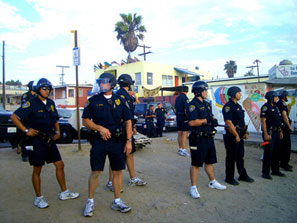
Who knew that the return of William J. Bratton to serve as New York police commissioner, a position he held from 1994 to 1996, would signal a return of some of the hoariest anti-police conceits from that era as well? In a column blasting Broken Windows policing (which targets public-order offenses like graffiti and turnstile jumping), New York Times reporter Ginia Bellafante dusts off one of the Times’s favorite questions from the 1990s: “Why doesn’t New York police itself like San Diego does?” San Diego lowered its violent crime rate from 1991 to 1998, and again from 2002 to 2012, by more than New York did, Bellafante says, without allegedly employing what she calls “broken-windows tactics.”
Times reporter Fox Butterfield regularly trotted out the same comparison in the 1990s, and it is even more inapt today than it was then. San Diego and New York’s demographics and crime profiles are worlds apart. San Diego doesn’t have a large entrenched underclass, nor did it ever have a serious violent-crime problem. Its murder rate in 1993, a year before Bratton took over the NYPD, was two-fifths that of New York. New York had 1,946 murders in 1993; San Diego had 133. Gang members did not—and do not—regularly gun each other down in San Diego as they still do in New York’s public housing projects. Yet despite San Diego’s much lower violent crime rate, in 1999, the allegedly pacific San Diego police department fatally shot civilians at 15 times the rate of the NYPD.
Finally, a reason to check your email.
Sign up for our free newsletter today.
What about that gap from 1998 to 2002 in Bellafante’s New York–San Diego comparison? Bellafante, drawing on a report from the John Jay College Center on Race, Crime, and Justice, has chosen her dates carefully. San Diego’s 1990s crime drop came to a screeching halt by the end of the decade, while the New York Police Department continued to bring crime down year after year—the only city in the country to do so. By 2002, when San Diego’s crime rate started dropping again, New York had already saved hundreds more lives.
Bellafante summarizes a recent City Journal article by Bratton and Manhattan Institute fellow George Kelling as “arguing essentially that minorities love ‘broken windows’ [and] that critics who don’t see this ‘have never been to a police/community meeting in a poorer, mostly minority neighborhood.’” There may or may not be a note of sarcasm in Bellafante’s summary; in any case, Bratton and Kelling’s point that public-order offenses are the main target of community complaints in poor, minority neighborhoods is simply undeniable. Over the years, I have heard the following requests and many more like them in police community meetings in inner-city New York: “There are youths congregating on my stoop, can’t you arrest them for loitering?” (from an elderly black woman in Central Harlem); “I smell marijuana in my hallways” (from a young Hispanic man in the South Bronx); “people hang out outside the club across from our building smoking weed” (from a young black woman in the Bronx’s Mott Haven section); “there are people barbecuing on the meridian strip of Broadway, isn’t that illegal?” (from a black woman on upper Broadway). An elderly cancer amputee in the Mount Hope section of the South Bronx will only go to her lobby to pick up her mail when she sees police around; otherwise, she is terrified of the youth trespassing in her lobby.
Broken Windows critics have never answered the question: What are the police supposed to do when they hear such complaints? Should they ignore these heartfelt requests for public order because broken windows policing allegedly “stigmatizes,” in Bellafante’s words, “black and Hispanic men who end up . . . burdened with fines and arrest records”? Should the police tell that elderly woman in Central Harlem, now the proud owner of her newly converted co-op, to deal with the teens on her stoop herself? Should tenants concerned by the smell of weed in their hallways just learn to live with it? Are they racist for being concerned about public drug use, even though they are minorities themselves? Should that cancer amputee simply cede her lobby to the marijuana-smoking, trespassing youth?
For decades, the main complaint about urban police departments was that they ignored crime in minority neighborhoods. Today, the NYPD focuses intensely on the most crime-ridden areas of the city, determined to free their residents from fear. And the main source of fear in these neighborhoods is public disorder, which signals that informal social controls have broken down, paving the way for more violent forms of lawlessness. Not every misdemeanor offense requires an arrest; sometimes a warning will suffice. But until the opponents of Broken Windows policing can persuade the law-abiding poor that public order doesn’t matter, NYPD commanders will rightly respond to their fervent desire for safe, orderly public spaces.